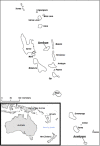Determinants of the use of insecticide-treated bed nets on islands of pre- and post-malaria elimination: an application of the health belief model in Vanuatu
- PMID: 25412704
- PMCID: PMC4289159
- DOI: 10.1186/1475-2875-13-441
Determinants of the use of insecticide-treated bed nets on islands of pre- and post-malaria elimination: an application of the health belief model in Vanuatu
Abstract
Background: Insecticide-treated nets (ITNs) are an integral piece of any malaria elimination strategy, but compliance remains a challenge and determinants of use vary by location and context. The Health Belief Model (HBM) is a tool to explore perceptions and beliefs about malaria and ITN use. Insights from the model can be used to increase coverage to control malaria transmission in island contexts.
Methods: A mixed methods study consisting of a questionnaire and interviews was carried out in July 2012 on two islands of Vanuatu: Ambae Island where malaria transmission continues to occur at low levels, and Aneityum Island, where an elimination programme initiated in 1991 has halted transmission for several years.
Results: For most HBM constructs, no significant difference was found in the findings between the two islands: the fear of malaria (99%), severity of malaria (55%), malaria-prevention benefits of ITN use (79%) and willingness to use ITNs (93%). ITN use the previous night on Aneityum (73%) was higher than that on Ambae (68%) though not statistically significant. Results from interviews and group discussions showed that participants on Ambae tended to believe that risk was low due to the perceived absence of malaria, while participants on Aneityum believed that they were still at risk despite the long absence of malaria. On both islands, seasonal variation in perceived risk, thermal discomfort, costs of replacing nets, a lack of money, a lack of nets, nets in poor condition and the inconvenience of hanging had negative influences, while free mass distribution with awareness campaigns and the malaria-prevention benefits had positive influences on ITN use.
Conclusions: The results on Ambae highlight the challenges of motivating communities to engage in elimination efforts when transmission continues to occur, while the results from Aneityum suggest the possibility of continued compliance to malaria elimination efforts given the threat of resurgence. Where a high degree of community engagement is possible, malaria elimination programmes may prove successful.
Figures
Similar articles
-
Insecticide-treated net use before and after mass distribution in a fishing community along Lake Victoria, Kenya: successes and unavoidable pitfalls.Malar J. 2014 Nov 28;13:466. doi: 10.1186/1475-2875-13-466. Malar J. 2014. PMID: 25431086 Free PMC article. Clinical Trial.
-
The use and misuse of mass distributed free insecticide-treated bed nets in a semi-urban community in Rivers State, Nigeria.Ann Afr Med. 2012 Jul-Sep;11(3):163-8. doi: 10.4103/1596-3519.96879. Ann Afr Med. 2012. PMID: 22684135
-
Community participation for malaria elimination in Tafea Province, Vanuatu: Part I. Maintaining motivation for prevention practices in the context of disappearing disease.Malar J. 2010 Apr 12;9:93. doi: 10.1186/1475-2875-9-93. Malar J. 2010. PMID: 20380748 Free PMC article.
-
A community-directed strategy for sustainable malaria elimination on islands: short-term MDA integrated with ITNs and robust surveillance.Acta Trop. 2010 Jun;114(3):177-83. doi: 10.1016/j.actatropica.2010.01.012. Epub 2010 Feb 2. Acta Trop. 2010. PMID: 20132788 Review.
-
Comparative effectiveness of malaria prevention measures: a systematic review and network meta-analysis.Parasit Vectors. 2018 Mar 27;11(1):210. doi: 10.1186/s13071-018-2783-y. Parasit Vectors. 2018. PMID: 29587882 Free PMC article. Review.
Cited by
-
Ownership and use of insecticide-treated nets in Myanmar: insights from a nationally representative demographic and health survey.Malar J. 2024 May 29;23(1):167. doi: 10.1186/s12936-024-04994-z. Malar J. 2024. PMID: 38807175 Free PMC article.
-
Community perceptions, acceptability, and the durability of house screening interventions against exposure to malaria vectors in Nyimba district, Zambia.BMC Public Health. 2024 Jan 24;24(1):285. doi: 10.1186/s12889-024-17750-4. BMC Public Health. 2024. PMID: 38267927 Free PMC article.
-
The role of perceived threat and self-efficacy in the use of Insecticide Treated Bednets (ITNs) to prevent malaria among pregnant women in Tororo District, Uganda.PLoS One. 2023 Jul 26;18(7):e0289097. doi: 10.1371/journal.pone.0289097. eCollection 2023. PLoS One. 2023. PMID: 37494377 Free PMC article.
-
Ideational factors associated with consistent use of insecticide-treated nets: a multi-country, multilevel analysis.Malar J. 2022 Dec 6;21(1):374. doi: 10.1186/s12936-022-04384-3. Malar J. 2022. PMID: 36474206 Free PMC article.
-
Climate-proofing a malaria eradication strategy.Malar J. 2021 Apr 17;20(1):190. doi: 10.1186/s12936-021-03718-x. Malar J. 2021. PMID: 33865383 Free PMC article. Review.
References
-
- WHO . World Malaria Report 2013. Geneva: World Health Organization; 2013.
-
- Atkinson JA, Bobogare A, Fitzgerald L, Boaz L, Appleyard B, Toaliu H, Vallely A. A qualitative study on the acceptability and preference of three types of long-lasting insecticide-treated bed nets in Solomon Islands: implications for malaria elimination. Malar J. 2009;8:119. doi: 10.1186/1475-2875-8-119. - DOI - PMC - PubMed
-
- Atkinson JA, Fitzgerald L, Toaliu H, Taleo G, Tynan A, Whittaker M, Riley I, Vallely A. Community participation for malaria elimination in Tafea Province, Vanuatu: Part I. Maintaining motivation for prevention practices in the context of disappearing disease. Malar J. 2010;9:93. doi: 10.1186/1475-2875-9-93. - DOI - PMC - PubMed
-
- Beer N, Ali AS, Eskilsson H, Jansson A, Abdul-Kadir FM, Rotllant-Estelrich G, Abass AK, Wabwire-Mangen F, Björkman A, Källander K. A qualitative study on caretakers’ perceived need of bed-nets after reduced malaria transmission in Zanzibar, Tanzania. BMC Public Health. 2012;12:606. doi: 10.1186/1471-2458-12-606. - DOI - PMC - PubMed
Publication types
MeSH terms
LinkOut - more resources
Full Text Sources
Other Literature Sources
Medical




